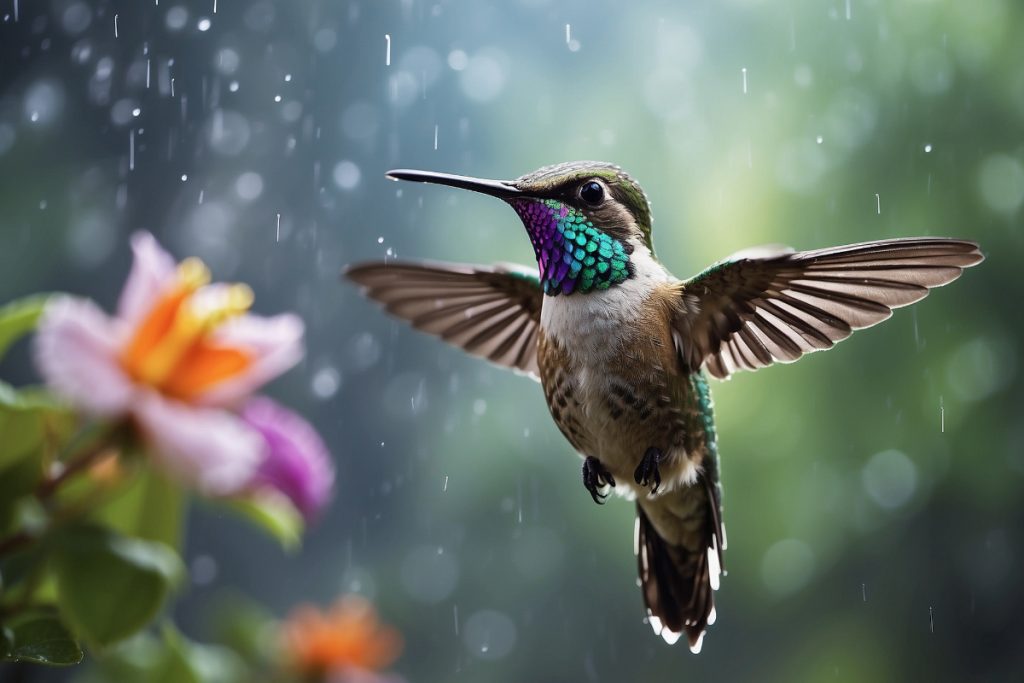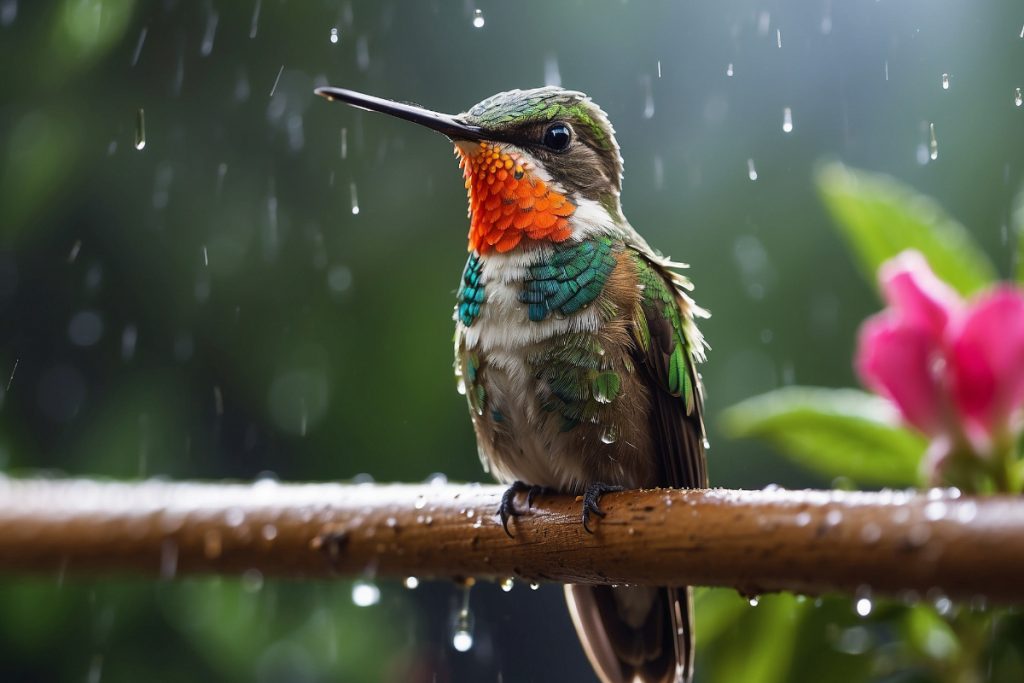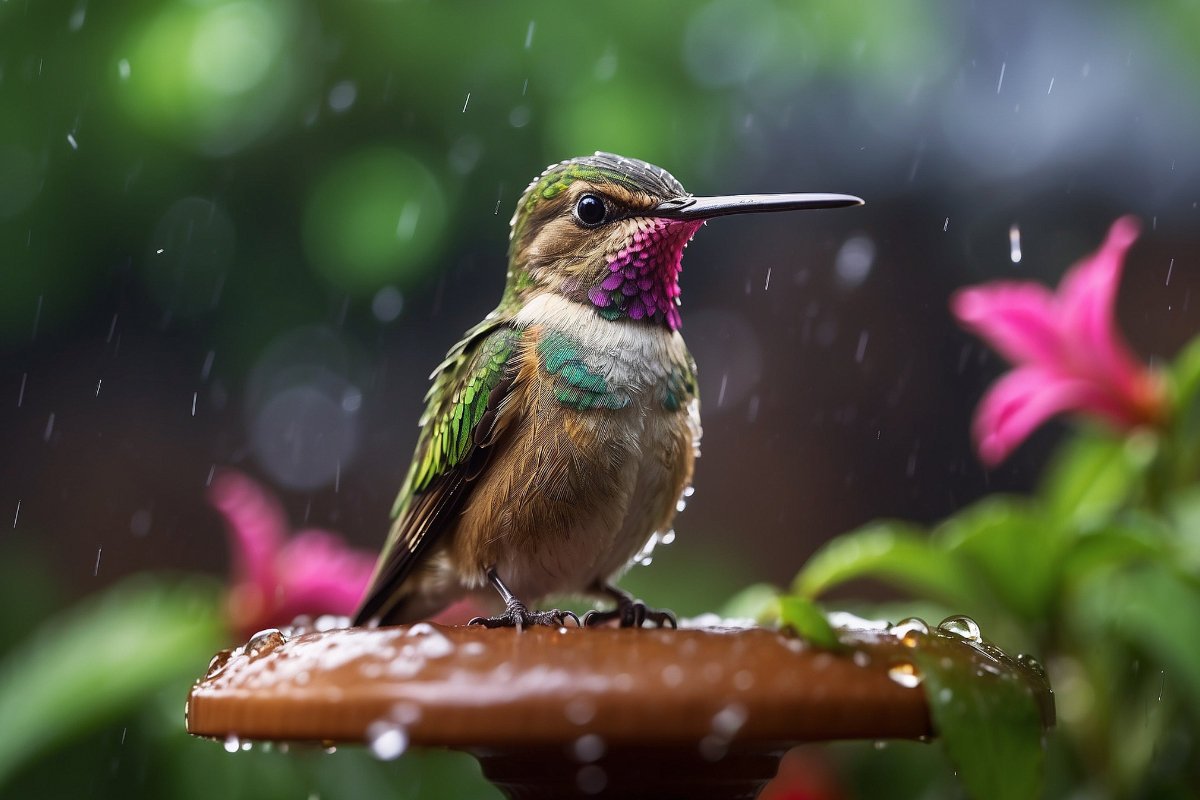Hummingbirds avoid flying in rainy conditions due to their small size, which makes it challenging to fly steadily amid heavy raindrops and because drenched feathers lose insulating abilities, causing them to lose body heat rapidly. Rain also makes it harder for them to see flowers to refuel with nectar and can blow them off course with gusty winds.
In this blog post, we will further explore other reasons why hummingbirds tend to avoid flying in rainy conditions.
Hummingbirds are remarkable little birds, and they have limitations when it comes to navigating stormy skies.
Related Post to Read: Where Do Hummingbirds Go When It Rains?

Why Is Flying in the Rain More Difficult for Hummingbirds?
Flying in the rain is more difficult for hummingbirds because rain conditions make the air heavier, making it more challenging for them to fly through the sky. Also, raindrops are heavy for their tiny bodies, which slows them down.
Plus, hummingbirds need to eat a lot because they use up energy very fast, and rain makes it hard for them to find food.
To further explain, there are other few key reasons why rainy conditions pose more of a challenge for these tiny birds:
Getting Waterlogged
I have mentioned this in the previous section, but I will elaborate again. Basically, the light, delicate feathers that enable effortless flight for hummingbirds can also become a liability in heavy rain.
If their feathers get soaked, it makes it much more physically demanding for hummingbirds to fly. Their wet feathers are heavier and lose their flexibility and aerodynamic structure.
Losing Body Warmness
In addition to hampering their movement, dampened feathers cause hummingbirds to lose essential body warmth rapidly. To maintain their high metabolisms, hummingbirds need to conserve their internal warmth. Plummeting temperatures put their health and safety at serious risk.
Impaired Vision
All those raindrops streaking through the air also compromise a hummingbird’s vision as they zip to and from flowers. With their sight obscured by precipitation, it’s more difficult for them to efficiently spot and feed from rain-drenched blossoms.
Battling Gusts
The blustery winds and unpredictable air currents that often accompany storms can easily blow tiny hummingbirds off course. Just a small gust is enough to displace their light bodies, forcing them to overexert themselves, battling the elements.
Fatigue
Merely hovering in place demands up to 80 wing beats per second from hummingbirds. Add heavy rains or winds into the equation, and the effort required for flight intensifies exponentially. The fatigue and exhaustion eventually cause them to look for shelter instead.
How Do Hummingbirds Take Cover in the Rain?
When inclement weather strikes, hummingbirds take advantage of their small size and agility to find protective nooks and crannies:
- Dense trees and shrubs
- Thick foliage
- Rain shelters
- Porch overhangs
- Empty nests.
They prefer to hunker down in covered areas that block rainfall but still allow them to perch. This protects their feathers from getting soaked while staying poised to zip back out for brief feeding forays between rain showers.
Providing a nearby rain shelter for hummingbirds can support their survival needs during extended storms. It gives them a safe space to hunker down without wasting precious energy reserves battling the elements.
Do Hummingbirds Get Stuck in the Rain?
Hummingbirds don’t tend to get stranded in downpours. If they do happen to get trapped by a sudden storm, they manage to shelter in safe places until it is safe for them to fly.
Their incredible metabolism powers rapid adaptations to shifts in climate and weather. Short bursts of exposure won’t seriously threaten their wellbeing.
However, prolonged, intense storms may jeopardise hummingbirds if they can’t consume enough nectar to meet their high energy requirements. In these cases, they may benefit from homeowners providing sugar water feeders so they can refuel.

The Resilient Nature of Hummingbirds
At the end of the day, hummingbirds are resilient creatures equipped to handle all kinds of conditions. Rainy weather may slow them down, but it takes quite extreme circumstances to put them in actual peril.
While they may seem delicate, hummingbirds are actually tough, adaptable birds. As long as they have access to shelter and adequate food sources, they can ride out storms and quickly bounce back to their energetic, hovering selves once sunny skies return.
Conclusion
Hummingbirds are incredibly capable of flying in all types of weather. However, as already discussed, heavy rains can undoubtedly present some substantial challenges for these petite birds. Simply avoiding lengthy exposure to pounding rain can enable them to retain body heat and energy.
Lastly, seeking shelter protects their specialised feathers from getting waterlogged so they can resume dazzling us with their midair magic when conditions clear. With their characteristic ingenuity and resilience, hummingbirds continue thriving even in the rainiest environments.
I hope you found this blog post helpful. If so, please share your thoughts in the comment section below.
Thanks for reading, and happy bird-watching.
Useful Links:
Related Posts to Read:
- 25 Hummingbird Behaviors.
- Do Hummingbirds Beaks Open When Feeding?
- 6 Fascinating Facts About Hummingbird Sizes.
- Hummingbird Diet and Nutrition.
- How Much Does A Hummingbird Eat Per Day?
- Do Hummingbirds Eat Bees?
- Do Hummingbirds Eat Wasps?
- Where Do Hummingbirds Go in the Winter?
References:
- About Hummingbird (Link).
- Greenewalt, C. H. (1960). Hummingbirds. New York: Doubleday. Google Scholar.
- Carey C. The impacts of climate change on the annual cycles of birds. Philos Trans R Soc Lond B Biol Sci. 2009 Nov 27; 364(1534):3321-30. doi: 10.1098/rstb.2009.0182. PMID: 19833644; PMCID: PMC2781852.
- Rico-Guevara A, Rubega MA, Hurme KJ, Dudley R. Shifting Paradigms in the Mechanics of Nectar Extraction and Hummingbird Bill Morphology. Integr Org Biol. 2019 Jan 2;1(1):oby006. doi: 10.1093/iob/oby006. PMID: 33791513; PMCID: PMC7671138.
- Tyrrell LP, Goller B, Moore BA, Altshuler DL, Fernández-Juricic E. The Orientation of Visual Space from the Perspective of Hummingbirds. Front Neurosci. 2018 Jan 30;12:16. doi: 10.3389/fnins.2018.00016. PMID: 29440985; PMCID: PMC5797624.
- Hummingbirds Sighting (Journey North Map).
- About Hummingbird’s Characteristics.
- About the Origins of Hummingbirds.
